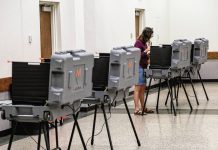Motorists interested in knowing when trains will pass through the State Road 46/State Road 11 intersection in Columbus have a new source of information.
Although train operators are not providing schedules, a heads-up notification is now available online.
A Columbus web-based train status page will allow anyone with Internet access to check if a train is approaching the busy west-side intersection so they may avoid the wait while traveling into or out of the city. Access to notifications about approaching trains can be reached at columbusrail roadproject.org.
The technology behind the page was designed by Isaiah Bowman, a Purdue Polytechnic Columbus senior who is completing his Bachelor of Science degree in computer information technology.
[sc:text-divider text-divider-title=”Story continues below gallery” ]
Columbus Mayor Jim Lienhoop and other city officials have been working with Purdue Polytechnic students since last year on a notification system for approaching trains. Louisville & Indiana Railroad, and the CSX trains that are using the line through Columbus, do not follow a regular schedule.
Longer, heavier and faster CSX trains this month will begin traveling through Columbus on L&I’s rail system. The railroad and CSX Transportation won approval in April 2015 from the federal Surface Transportation Board to use L&I’s 106-mile mainline between Louisville and Indianapolis jointly and upgrade it.
The plan calls for CSX to shift an estimated 13 to 15 trains per day to the L&I line, in addition to the L&I trains. A 2016 study by Indianapolis engineering firm American Structurepoint Inc. indicated as many as 22 trains may travel through the State Road 46/State Road 11 intersection, and other Columbus downtown intersections.
Increased train traffic will mean inconvenience for people who want to access Mill Race Park, Mill Race Center or the city bus depot, all on the west side of the tracks from Lindsey Street, Lienhoop said.
Development steps
Bowman, 22, is an Indianapolis native who is on a work-study program with Cummins, Inc.
He began working on the train-notification system in August 2017 with a team of three other Purdue Polytechnic students, assisting city officials to select detection cameras and tools that would allow a notification system to work reliably.
Bowman volunteered to stay with the project through completion this year, working with city and county officials to develop a web-based status page that will work on desktop and mobile devices and will not require users to download an application to use it.
He took on this challenging project in addition to his full-time university course load and work-study responsibilities at Cummins, city officials said.
“I have really learned a lot about the practical uses of computer technology. Since I moved to the west side of Columbus, I have a particular stake in the system working, as I plan to use it to make sure I can get to class and work on time,” he said.
Bowman said he was drawn to do a real-world project, rather than a school scenario assignment. In this case, Bowman said he had no prior experience with trains, cameras or even web development when he signed on.
“I learned quite a bit,” he said. “One of the biggest issues was our lack of experience. We initially didn’t know the scope of what we were working on.”
The students soon realized there are a lot more nuances to a real-world project, Bowman said, which resulted in needing more time than anticipated to complete the project.
He described the notification system as the first version of what could become a more sophisticated version in the future, one that might eventually inform motorists exactly where the train is when detected by the cameras, and how long it will take for the train to travel through Bartholomew County.
How it works
A network of cameras has been installed by the city and county which will allow a live video feed of key intersections along the train route for use by emergency management officials. The network specifically records intersections at County Road 950S, County Road 200S and State Roads 46 and 11.
When motion is detected at the intersections, an email alert is sent to the web-notification system, triggering a box on the website to turn from “all clear” in green to red with the message “train detected.” The system only detects northbound trains as CSX is sending southbound trains on a different route, according to the city. Most southbound trains crossing at the State Road 46 intersection are local traffic — short trains, city officials said Tuesday.
Bowman said the idea of his notification system is to tell a motorist heading out that a northbound train is likely on the tracks and is or will be blocking the State Road 46/State Road 11 intersection shortly, he said. The notification system does not differentiate between a two-locomotive train passing through or a much longer one. And it does not indicate specific times a train is passing by each camera.
However, it does signal the possibility of a delay at train intersections in Bartholomew County, allowing a person to decide on a different route if they wish, said Bowman, who uses the system each morning on his way to Purdue Polytechnic.
If a train is blocking crossings in Columbus, west-siders may opt for the Lowell Road and County Road 325W bypass around the north side of the city, which has an overpass over Interstate 65 and over the train tracks.
Data so far shows the predicted increase in train traffic has not yet occurred, Bowman said.
Word-of-mouth tracking
The train-crossing cameras are not yet a part of the county’s emergency 911 system, although city and county officials are discussing giving access to dispatchers.
Todd Noblitt, director of the Bartholomew County 911 Emergency Operations Center, said if dispatchers had the camera feed on a screen, they could notify first responders of an approaching train and avoid possible delays for police, fire trucks and ambulances. Right now, dispatchers rely on first responders in the area of the tracks to notify dispatchers if a train is approaching or blocking an intersection and re-route first responders to the call.
Noblitt said it is up to first responders how they get to an emergency scene, although dispatchers do warn of possible train delays.
Columbus Regional Health and the Columbus Fire Department have moved ambulances and specialized fire equipment to west-side fire stations in preparation for anticipated train delays.
The fire department has completed refurbishing a 20-year-old unit at a cost of $150,000 as the second heavy rescue unit serving the department, this one out of Columbus Fire Station 5 on Terrace Lake Road west of Interstate 65. It will primarily be used for mutual aid calls within Bartholomew County when the main Squad 2 is on an emergency call, the fire department said.
Station 5 firefighters will be able to transfer to Squad 5 for serious motor vehicle incidents and extrications on the city’s west-side, including I-65 and West State Road 46. City data shows that from 2013 to 2018, a third of all motor vehicle extrications were on the west side of Columbus.
The decision to place a heavy rescue unit on the west side at Station 5 is a proactive approach to prepare for increased trains, as well as anticipated construction of a new west-side State Road 46 overpass, Fire Chief Mike Compton said.
While the notification provides some advance notice that a train delay is possible, city officials cautioned that the notifications should not be any encouragement to disregard speed limits or to disregard any traffic laws in an effort to beat an approaching train.
“We are thoroughly impressed with Isaiah’s work on this project and are excited to share this tool with residents and visitors to allow travel in and out of Columbus to be much smoother and safer,” Lienhoop said. “We encourage all to use the status page responsibly while obeying state and local vehicle laws.”
Bowman has told city and county officials he will remain with the project through early 2019 to make any additional adjustments to the notification page that are necessary.
[sc:pullout-title pullout-title=”For more information” ][sc:pullout-text-begin]
Access to notifications about approaching trains can be reached at columbusrailroadproject.org.
When you reach the page, click on the green button at the top right of the page. You will be asked to agree to the terms of use and then will be given the current status of trains on the tracks in Bartholomew County. Green means that no trains have been detected. Red means a train has been detected and delays are possible.
[sc:pullout-text-end]




